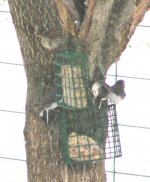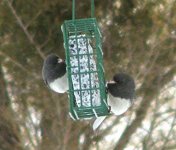wvbirdwatcher
Well-known member
We have Dark-Eyed Juncos here in the winter. In fact, I have never seen so many as in this winter. They sure do seem to love the snow! We had snow cover here for six or more straight weeks, very unusual for this area. My question is: Is late February too early for them to start migrating north? We had 15 inches of snowfall on February 13th, and, as usual, there were many Juncos on the suet feeders and grazing under it. But after most of the snow was melted, I hardly saw any Juncos. Since that time, I have seen a couple of Juncos, but nowhere near the dozen or so that I used to see during a single viewing. Here is a picture I took on February 15th when there was still plenty of snow on the ground. The bird at the top is a Sparrow, but the rest are Juncos.






